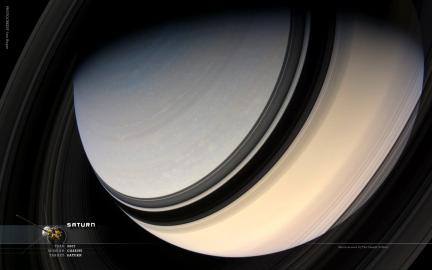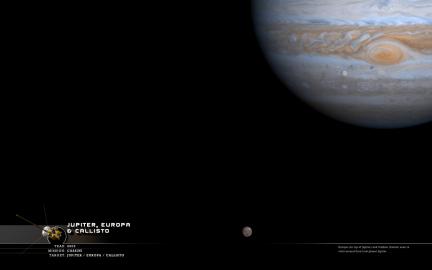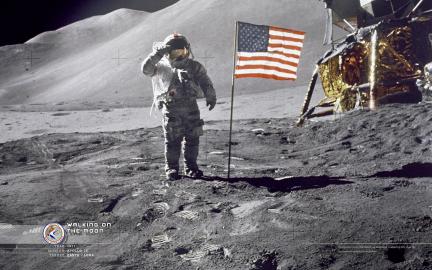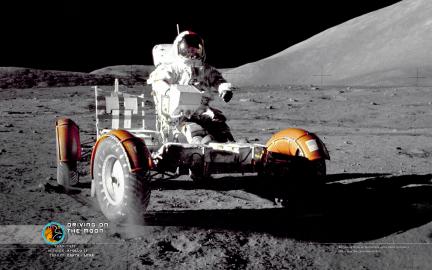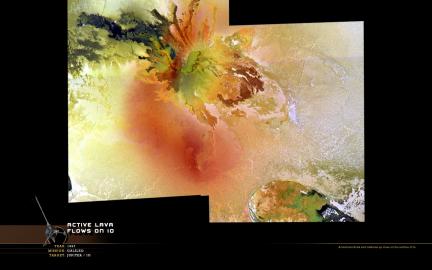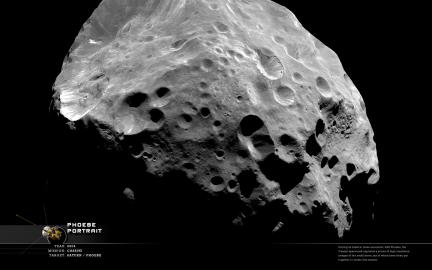 A few posts back I uploaded a closer detail of this same image. This is the best “portrait” image of Phoebe available taken by Cassini on its way into the Saturn system and orbit insertion. Being so far out from the rest of the most dle scientific targets (4x as far as Iapetus), this was the only up-close visit planned to the tiny moon who’s size is about 220km average width.
A few posts back I uploaded a closer detail of this same image. This is the best “portrait” image of Phoebe available taken by Cassini on its way into the Saturn system and orbit insertion. Being so far out from the rest of the most dle scientific targets (4x as far as Iapetus), this was the only up-close visit planned to the tiny moon who’s size is about 220km average width.
Wallpaper: Phoebe
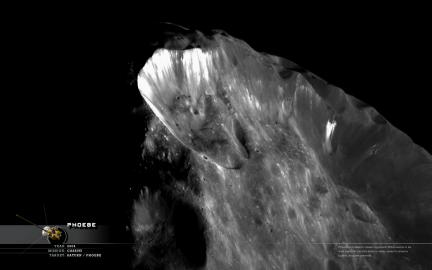 There appears to be a layer of dark material covering the small moon Phoebe as revealed by the collapse of materials in the northern region of the small moon. Phoebe orbits Saturn outside the orbit of Iapetus and has been considered a possible candidate for the dark material also found covering one side of that unusual moon. What may have caused this transfer of materials is still a mystery… or that Phoebe had anything to do with that feature on Iapetus is still very much in question.
There appears to be a layer of dark material covering the small moon Phoebe as revealed by the collapse of materials in the northern region of the small moon. Phoebe orbits Saturn outside the orbit of Iapetus and has been considered a possible candidate for the dark material also found covering one side of that unusual moon. What may have caused this transfer of materials is still a mystery… or that Phoebe had anything to do with that feature on Iapetus is still very much in question.
Some propose that Phoebe is actually a captured comet from the Kuiper belt (a region of small bodies orbiting the sun beyond Neptune of which Pluto is considered a member). If this is true, the images taken by cassini would be the only images of such bodies to be anything other than a single point of light.
Wallpaper: Southern Saturn
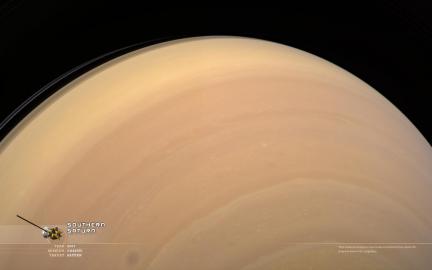 According to the Cassini website, this image was taken at about 58 degrees below the ring-plane in the southern hemisphere. The southern lower half of Saturn tends to appear yellow-peach while (at current) the northern half of Saturn leans to a white-grey-blue, with varying effects from the shadows of the rings cast upon the cloud tops (just visible on the middle-left). It is unusual to view such a large area of Saturn’s globe without the intrusion of rings or ring-shadows and it reminds us how gorgeous Saturn would be even without its stunning rings.
According to the Cassini website, this image was taken at about 58 degrees below the ring-plane in the southern hemisphere. The southern lower half of Saturn tends to appear yellow-peach while (at current) the northern half of Saturn leans to a white-grey-blue, with varying effects from the shadows of the rings cast upon the cloud tops (just visible on the middle-left). It is unusual to view such a large area of Saturn’s globe without the intrusion of rings or ring-shadows and it reminds us how gorgeous Saturn would be even without its stunning rings.
Wallpaper: Ganymede Up Close
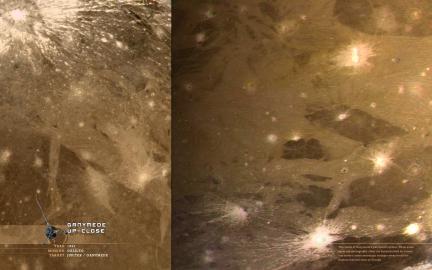 Two views of Ganymede’s patchwork surface taken by Galileo around 1997. While some areas appear geologically older (as demonstrated by the record of impact cratering) some seemingly younger areas recall the fracturous features seen at Europa. Many theorize, just as they do at Europa, that there may be a global ocean of water beneath the surface at Ganymede. However, it is also assumed (if if this does exist) that this ocean would be more shallow and under a much thicker crust of rock hard ice than that of Europa.
Two views of Ganymede’s patchwork surface taken by Galileo around 1997. While some areas appear geologically older (as demonstrated by the record of impact cratering) some seemingly younger areas recall the fracturous features seen at Europa. Many theorize, just as they do at Europa, that there may be a global ocean of water beneath the surface at Ganymede. However, it is also assumed (if if this does exist) that this ocean would be more shallow and under a much thicker crust of rock hard ice than that of Europa.
Wallpaper: Geysers on Enceladus
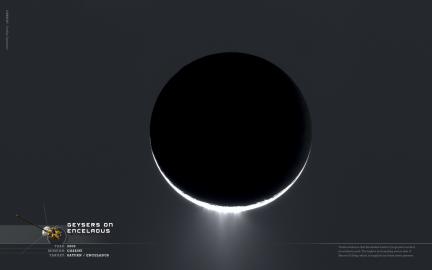 Visual evidence that Enceladus hosts cryo-geysers around its southern pole. The lighter surrounding area is due to Saturn’s E-ring, whose materials are supplied by these same geysers.
Visual evidence that Enceladus hosts cryo-geysers around its southern pole. The lighter surrounding area is due to Saturn’s E-ring, whose materials are supplied by these same geysers.
This is another image supplied by Mr. Gordan Ugarkovic who notes that “this is a colorized image, artificial color was added to make the plumes and E ring subtly bluish, while saturnlit portion of Enceladus slightly brownish. In reality no color frames were taken, only clear filter ones”.
Wallpaper: Ariel Portrait
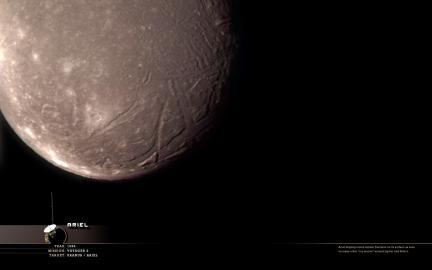 Ariel is the third of the five larger moons or Uranus. It is somewhat similar to Saturn’s Rhea in composition, about 30% rock and 70% ices. There are obvious ridges and details that would appear to be somewhat “young” features (which is still quite old to you and me), but there is little known about this moon as it was only viewed once from 127,000 km by Voyager 2.
Ariel is the third of the five larger moons or Uranus. It is somewhat similar to Saturn’s Rhea in composition, about 30% rock and 70% ices. There are obvious ridges and details that would appear to be somewhat “young” features (which is still quite old to you and me), but there is little known about this moon as it was only viewed once from 127,000 km by Voyager 2.
Wallpaper: Dione’s Ice Cliffs at Crescent
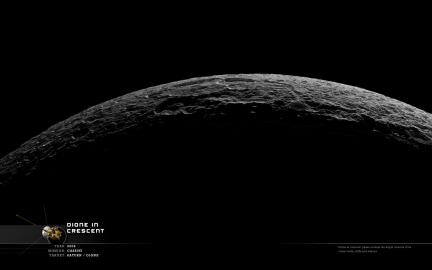 An almost Apollo class image of the cliffs of Dione rising at its horizon. Many of the cliffs pictured here are from impact craters, but Dione is also well known for its “wispy” details which have been revealed by Cassini as fractures which result in giant ice cliffs and valleys. You can see one crater actually cross-sectioned by one of these fractures at the extreme far right side of the wallpaper image above.
An almost Apollo class image of the cliffs of Dione rising at its horizon. Many of the cliffs pictured here are from impact craters, but Dione is also well known for its “wispy” details which have been revealed by Cassini as fractures which result in giant ice cliffs and valleys. You can see one crater actually cross-sectioned by one of these fractures at the extreme far right side of the wallpaper image above.
The origins of these fractures are yet unknown and it is generally accepted that these are relatively recent formations as many of them run through impact craters which are known all over the solar system to be ancient details. As a matter of fact, impact cratering is how most planetary scientists are able to rate the age of a surface by the absence or presence of crater events. Bodies with many craters (our moon, Callisto and Mercury) are considered to be old and generally unchanged since early in its formation history as it is assumed that the period of heavy cratering happened soon after the formation of the solar system. Bodies with less cratering (like Earth, Io and Titan) are considered to have “young” surfaces which have been geologically changed over the ages and erased the record of impact cratering.
Wallpaper: Mars Sunset Over Husband Hill
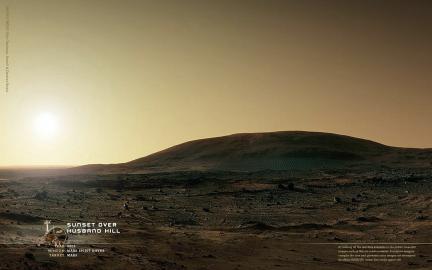 This is another fine example of freelance imagers at work. Many of whom spend time at unmannedspaceflight.com.
This is another fine example of freelance imagers at work. Many of whom spend time at unmannedspaceflight.com.
Wallpaper: Europa Portrait Render
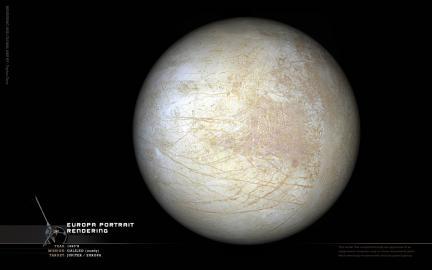 The previous Europa portrait posted here, is the most commonly seen image of the full globe of Europa. Even though there have been multiple missions to Jupiter and its system of moons (including an orbiter which stuck around for quite a while)… there are surprisingly few full globe images of Europa. The one used in the previous post mentioned was compiled through several filters but due to some incomplete data, an artificial green haze appears at the right edge of the disc. Considering the scientific importance of Europa and its unique appearance makes a full globe view of this world highly desirable in my mind.
The previous Europa portrait posted here, is the most commonly seen image of the full globe of Europa. Even though there have been multiple missions to Jupiter and its system of moons (including an orbiter which stuck around for quite a while)… there are surprisingly few full globe images of Europa. The one used in the previous post mentioned was compiled through several filters but due to some incomplete data, an artificial green haze appears at the right edge of the disc. Considering the scientific importance of Europa and its unique appearance makes a full globe view of this world highly desirable in my mind.
Enter Tayfun Öner who is the author of the above render. This model was created by stitching together a map of the Europan surface from a multitude of images. At this point in history, a good amount of Europa has been photographed and allows one to make an almost complete surface map as seen below. The clearest and best resolved regions of the map are likely from the Galileo mission and where gaps appeared from that mission the spaces were filled in with images taken by Voyager. 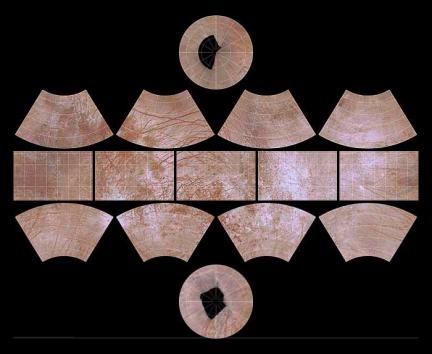 I usually prefer straight photography for the puposes of this site, but this is one of the most impressive renders I have ever seen of any body in the solar system. Seeing as how data sets for full global images of Europa are flawed at best… this render does the job most impressively. The full hi-res set of Europa maps by Tayfun can be found here for the curious.
I usually prefer straight photography for the puposes of this site, but this is one of the most impressive renders I have ever seen of any body in the solar system. Seeing as how data sets for full global images of Europa are flawed at best… this render does the job most impressively. The full hi-res set of Europa maps by Tayfun can be found here for the curious.
Wallpaper: Looking Back at Earth
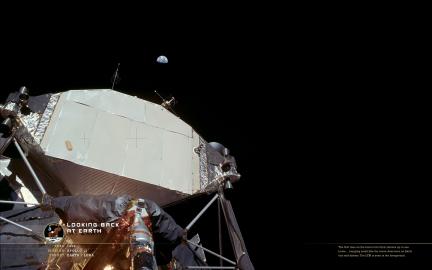 Trying to get some decent Apollo images on here from time to time. So many of these images are so often seen that I want to focus on the ones that really are great but are rarely seen.
Trying to get some decent Apollo images on here from time to time. So many of these images are so often seen that I want to focus on the ones that really are great but are rarely seen.
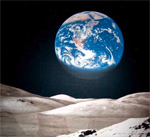 Seeing the size of Earth as it really appears from the surface of the moon reminds me of this wallpaper that I grew up with in my room as a child. I always assumed it was an actual image, but in reality the Earth appears about 1/20 the size and Earth would never phase in shadow from north to south under any circumstance! (I missed that obvious flaw as pointed out by Paul Neave). I beleive they still sell this wallpaper as I still see it around occasionally at stores and other public spaces (no pun). In addition to this image, you also see the Earth from moon shots taken while in- moon-orbit which also gives the Earth a far larger appearance… but I suspect that some good zoom lenses were likely utilized to get those looks as well.
Seeing the size of Earth as it really appears from the surface of the moon reminds me of this wallpaper that I grew up with in my room as a child. I always assumed it was an actual image, but in reality the Earth appears about 1/20 the size and Earth would never phase in shadow from north to south under any circumstance! (I missed that obvious flaw as pointed out by Paul Neave). I beleive they still sell this wallpaper as I still see it around occasionally at stores and other public spaces (no pun). In addition to this image, you also see the Earth from moon shots taken while in- moon-orbit which also gives the Earth a far larger appearance… but I suspect that some good zoom lenses were likely utilized to get those looks as well.
Wallpaper: Saturn Portrait II
Wallpaper: Rhea Portrait
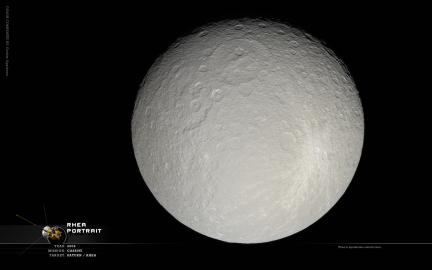 Rhea is the second largest of Saturn’s moons but lacks any of the exciting features of some of the others. It has some of the “wispy” features that have been determined to be ice cliffs on Dione, but they are far less prominent here. Just another big ball of water ice for future earth visitors to mine for resources!
Rhea is the second largest of Saturn’s moons but lacks any of the exciting features of some of the others. It has some of the “wispy” features that have been determined to be ice cliffs on Dione, but they are far less prominent here. Just another big ball of water ice for future earth visitors to mine for resources!
Wallpaper: Tethys Portrait
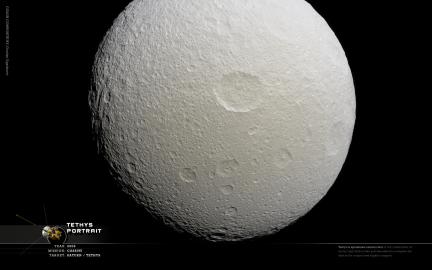 One of the mid-sized moons of Saturn, Tethys, is thought to be composed almost entirely of water ice. Its most remarkable features are Odysseus, a 400 km wide crater and the Ithaca Chasma a 2,000 km long valley that runs across 2/3 of Tethy‘s globe. Those features are not visible in this image, but what is visible is the slight color variation which almost appears as a “dusting” of color on a largely grey body. A curious feature especially considering the radical color variation found at Iapetus. Perhaps this discoloring is a more subtle result of the same event which caused the strange color variation on Iapetus?
One of the mid-sized moons of Saturn, Tethys, is thought to be composed almost entirely of water ice. Its most remarkable features are Odysseus, a 400 km wide crater and the Ithaca Chasma a 2,000 km long valley that runs across 2/3 of Tethy‘s globe. Those features are not visible in this image, but what is visible is the slight color variation which almost appears as a “dusting” of color on a largely grey body. A curious feature especially considering the radical color variation found at Iapetus. Perhaps this discoloring is a more subtle result of the same event which caused the strange color variation on Iapetus?
Mars Reconnaissance Orbiter’s Got Good Eyes
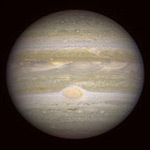 This is a great way to truly understand the capabilities of the Mars Reconnaissance Orbiter. This image of Jupiter is taken from Martian orbit which is 357 million miles away. It is comparable to the what the New Horizons is seeing as it actually approaches Jupiter, which is currently 38 million miles away. So if you were wondering how MRO can get those incredibly detailed images of rovers and landers on the surface from orbit… now you can scratch your head and wonder how it can see Jupiter as good as a probe that is actually approaching a flyby in a few weeks.
This is a great way to truly understand the capabilities of the Mars Reconnaissance Orbiter. This image of Jupiter is taken from Martian orbit which is 357 million miles away. It is comparable to the what the New Horizons is seeing as it actually approaches Jupiter, which is currently 38 million miles away. So if you were wondering how MRO can get those incredibly detailed images of rovers and landers on the surface from orbit… now you can scratch your head and wonder how it can see Jupiter as good as a probe that is actually approaching a flyby in a few weeks.
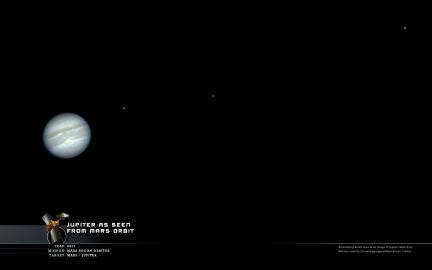
Okay, so not as exciting a wallpaper as most… but it was taken from Mars and you can see (i’m guessing) is Europa, Ganymede and Callisto in the same shot.
Wallpapers: Jupiter and Moons
Wallpapers: Three From Apollo
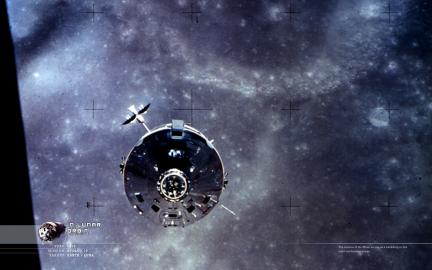 A few decades ago, about 12 men walked upon the surface of another celestial body for the first time in history. At one point, Neil Armstrong looked up at Earth and blotted it out with his thumb and thought the significance of that simple act. “That's home. That's us. On it, everyone you ever heard of, every human being who ever lived, lived out their lives. The aggregate of all our joys and sufferings, thousands of confident religions, ideologies and economic doctrines, every hunter and forager, every hero and coward, every creator and destroyer of civilizations, every king and peasant, every young couple in love, every hopeful child, every mother and father, every inventor and explorer, every teacher of morals, every corrupt politician, every superstar, every supreme leader, every saint and sinner in the history of our species, lived there on a mote of dust, suspended in a sunbeam”. While these were not Armstrong’s words, but instead Carl Sagan’s, it is clear that it is along these similar lines he was thinking.
A few decades ago, about 12 men walked upon the surface of another celestial body for the first time in history. At one point, Neil Armstrong looked up at Earth and blotted it out with his thumb and thought the significance of that simple act. “That's home. That's us. On it, everyone you ever heard of, every human being who ever lived, lived out their lives. The aggregate of all our joys and sufferings, thousands of confident religions, ideologies and economic doctrines, every hunter and forager, every hero and coward, every creator and destroyer of civilizations, every king and peasant, every young couple in love, every hopeful child, every mother and father, every inventor and explorer, every teacher of morals, every corrupt politician, every superstar, every supreme leader, every saint and sinner in the history of our species, lived there on a mote of dust, suspended in a sunbeam”. While these were not Armstrong’s words, but instead Carl Sagan’s, it is clear that it is along these similar lines he was thinking.
It is easy to forget how incredible those moments were as they happened so long ago, and the first of these was some months before I even existed as a person. We have grown accustomed to these images of men walking on the moon, in no small part because a follow up is so long overdue that they seem antiquated or quaint. So it seemed to me that out of 50 wallpapers uploaded it might be appropriate to include man’s first exploration of any of these places as part of the collection.
Wallpaper: Triton Cryo-Volcanos
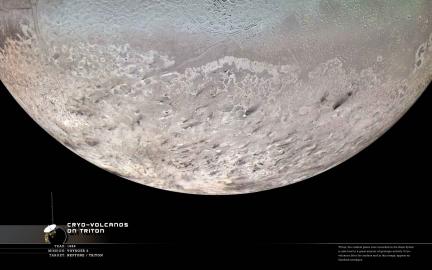 As of this time, Triton (a moon of Neptune) has the coldest temperature ever recorded in human history on any terrestrial surface… -235 C, -391 F. At these temperatures, nobody would have expected anything other than a huge frozen solid ice ball. Instead, Triton is littered with what we now call cryo-volcanos… or cold volcanos. They erupt or eject materials other than molten rock, such as water, ammonia or methane. As we are seeing in places like Titan (who is also suspected of having cryo-volcanos) many characteristics of Earth geology and weather are simulated elsewhere in the Solar System with different materials. On Earth it rains water, but on Titan it rains methane, and likewise on Triton it erupts probably liquid nitrogen instead of magma as it does here on Earth.
As of this time, Triton (a moon of Neptune) has the coldest temperature ever recorded in human history on any terrestrial surface… -235 C, -391 F. At these temperatures, nobody would have expected anything other than a huge frozen solid ice ball. Instead, Triton is littered with what we now call cryo-volcanos… or cold volcanos. They erupt or eject materials other than molten rock, such as water, ammonia or methane. As we are seeing in places like Titan (who is also suspected of having cryo-volcanos) many characteristics of Earth geology and weather are simulated elsewhere in the Solar System with different materials. On Earth it rains water, but on Titan it rains methane, and likewise on Triton it erupts probably liquid nitrogen instead of magma as it does here on Earth.
Only two active cryo-volcanos have been confirmed on Triton, but it is generally assumed that each one of those black smudges visible in this image are the remnants of recently active cryo-volcanos. There are quite a few…
Wallpaper: Dione Portrait
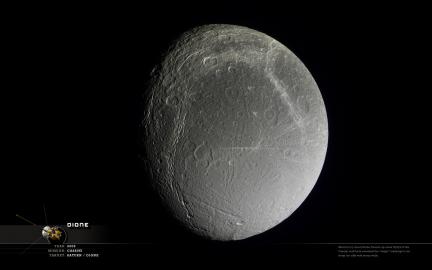 Saturn’s moon Dione seen at almost full disk. Recently the “wispy” markings have been revealed to be giant ice cliffs as seen by the Cassini spacecraft after coming close to 500km from the surface. The cliffs reach as high as several hundred meters high and are thought to be the result of ancient tectonic fractures.
Saturn’s moon Dione seen at almost full disk. Recently the “wispy” markings have been revealed to be giant ice cliffs as seen by the Cassini spacecraft after coming close to 500km from the surface. The cliffs reach as high as several hundred meters high and are thought to be the result of ancient tectonic fractures.
Wallpaper: Io Lava Flows
Wallpaper: Deep Impact Makes Contact
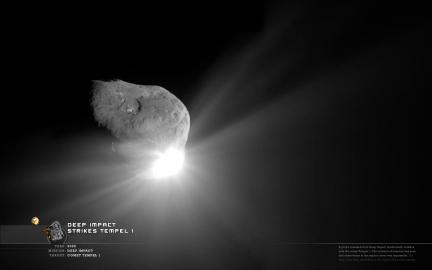 One of the expectations of ramming a space probe into a comet was to be able to see the resulting crater. The Deep Impact collider was released and the Deep Impact probe continued on from a distance to record the impact. What it saw was a blast much larger than expected and was so large that direct visual observance of the resulting crater became impossible. However, the same thing which kept us from seeing some of these results is the same plume of ejected material that has told us that more about this comet’s composition and how the surface materials are held together quite weakly.
One of the expectations of ramming a space probe into a comet was to be able to see the resulting crater. The Deep Impact collider was released and the Deep Impact probe continued on from a distance to record the impact. What it saw was a blast much larger than expected and was so large that direct visual observance of the resulting crater became impossible. However, the same thing which kept us from seeing some of these results is the same plume of ejected material that has told us that more about this comet’s composition and how the surface materials are held together quite weakly.
